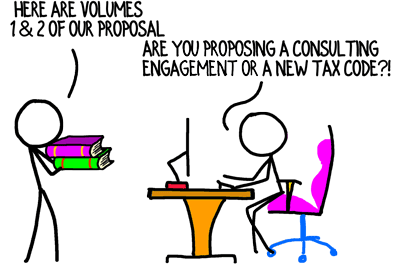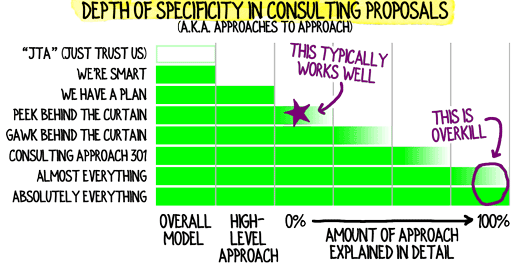May Bezold, EVP of the Post-Revelry division at Back2Work, Inc., has asked your consulting firm for a proposal.
You know from experience that if you share too little of your approach, a prospect like May won’t sign.
However, sharing too much detail also leads to problems.
What’s the right amount of information to share about your consulting firm’s approach, and why?

As always, consulting isn’t about you or your consulting firm. It’s about your THEM – your clients and prospects.
May, like most of your prospects, doesn’t inherently want to know anything about your consulting firm’s approach, except out of intellectual curiosity.
Although you’re interested in the details and the nuances, all she’s thinking is, “Is this going to work?”
What May really wants to know is that your consulting firm is a credible, reliable solution to her Post-Revelry headaches.
Therefore, the right level of detail to share is the minimum necessary to reassure May that your approach is reliable and your consulting firm is a credible provider. No more.
Action Step
Before you populate the Approach section of your proposal, reflect on your prospect’s stance:
- How skeptical has she appeared to be?
- What concerns and doubts did she express about the process?
- What, if any, process signals did she send? These sound like, “How, exactly, would you work with us?” or, “We tried this with another consultant and it didn’t work—how would this be different?”
- What level of detail did she indicate she is expecting in the proposal?
A more skeptical prospect requires more proof points and a stronger model, not necessarily a more detailed approach.
On the other hand, approach-related concerns and signals should be addressed with greater detail in your proposal.
Does Any of This Matter?
What’s the problem with adding some extra detail to a proposal or even submitting a fully tricked out approach?
That’s a fair question.
If you’re feeling insecure about an assignment, you may over-share. Some firms also over-share out of habit. Here are some downsides:
- Revealing your approach in detail can commoditize your work. Even though it’s your experience, not the mystery of the approach, that clients are buying, when your approach looks too much like a detailed set of steps, the perceived value can drop.
- Detailed proposals restrict your consulting firm’s ability to maneuver, tweak or totally change the approach in response to on-the-ground conditions. You’re caught between the proposed approach and the client’s Desired Outcome.
- Additional detail can confuse your prospect, surface questions that are pushed down to lower-level staff, and slow down or stop the approval process in its tracks.
- Unless your proposal uses boilerplate language, including unnecessary detail adds to your proposal development time and reduces your productivity.
- There’s an off chance (albeit not highly likely) that if you share too much detail, your prospect will decide she can handle parts of the project or the entire project using her internal team.
Take May Bezold’s request for a proposal as a sign that she views your consulting firm as likely solution to her Post-Revelry headache.
Push past your insecurity, and slim down the approach section of your proposal.
One final note: Rightly or wrongly, clients do link perceived difficulty with perceived value. Therefore, don’t oversimplify your approach or leave out all details.

The sweet spot is usually a proposal that presents an excellent model, an overview of the approach, and a sprinkling of detail to reassure May that your approach has depth and rigor.
Quick question (please answer in the comments):
Have you ever won a project after editing out some detail in the approach section of your proposal? If so, what amount of detail worked for you?
Text and images are © 2024 David A. Fields, all rights reserved.

 David A. Fields Consulting Group
David A. Fields Consulting Group 

Hi David – HNY. Such a coincidence to get your email alert, as I was just off the call with a prospect who requested me to list a few bullets with my ideas, before we agree a way forward. After judging it was a strong Buy signal, I ended up with four one-line bullets – that set out the areas I will be consulting on & how it might benefit them – without going into any detail on the content. On the lines of:
“Initially, by way of an initial consultancy project, I am happy to list:
1. Suggestions for increasing compliance measures to increase trust in your brand, whilst not damaging the ease of doing business.
2. …
”
Only time will tell if this succeeds.
Great case study, Amit. Another way to think of your prospect’s request is it’s a strong, “I won’t waste your time” signal, and that’s very good. Maybe they’ll move forward, and even if they don’t (yet), you’ve efficiently and effectively deepened your relationship and connection.
Definitely keep me apprised of how your opportunity turns out!
When I was a younger consultant at McKinsey, I would review the proposal we used to win our projects. Initially, I would often feel like the proposals were pretty open-ended. It was frustrating to think “they confirmed this work and didn’t have a detailed plan!”
Later as a project manager, I saw the value in working with the partner to build out team-level plans and ‘manager guides’. Preparing for a project, either I or the project director typically had a lot of material to guide the team and build more detailed plans. An extra benefit from leaving some details out was that it forced the working team to actually tailor the approach to the on-the-ground details they were hearing as they worked closely with the client teams.
In hindsight, I wish I had read this article way back then as an associate!
Very interesting perspective, Michael. Your case study reinforces two important points: 1) Trust is the currency in which consulting projects are priced and purchased; therefore, clients don’t necessarily need or want details before they sign. 2) Less detail up front give you more flexibility to construct the best project at the time of execution.
Separately, some owners of small consulting firms would argue the practice you outlined is a good reason to engage a small consultancy rather than a mega-firm. As a small firm with deep expertise in your niche, you have enough on-the-ground knowledge to tailor the work before the proposal is signed.
Thank you for sharing your case study and underscoring those important points, Michael.
Dave
This email is perfectly timed as I was drafting out an outline of what I plan to discuss with a prospective client and felt it might be “Over Kill”. The zoom discussion is this Friday and I’ve thought of sending them an email to ask if there is anything specific they would like for us to go over.
Thank you,
Outstanding, Kevin. Checking in with the client first is always a good course of action. You can stay focused on their needs (reassurance) versus your process.
Let me know how the meeting goes!
David- I wish I had read this article an year ago. For my very first consulting project, I sent a very detailed (step by step including example flow chart) proposal of four pages. The result was that the client commoditized my proposal – choosing to do parts of the work internally and the other parts going to a cheaper resource. And the client ghosted my inquiries later. Hard way to learn what went wrong..
Nowadays, ever since I read your guide, I just use the ‘right side up’ thinking and have been landing projects, slowly but for sure!
Great pearls of wisdom! Thanks a lot for sharing!!
Good on you, VR, for learning that lesson after only one proposal went sideways. Many consultants persist through round after round of commoditizing themselves.
Also, thank you for sharing your experience. Your example will provide comfort and reassurance to many other readers who have faced (or will face) similar circumstances. You rock!
David,
This is spot-on. I cannot say that I won a project as a result of reducing the information that I provided, but unfortunately, I can definitely point to a project that I am certain I lost because I overshared too much information. This is a lesson that a consultant HAS to keep in mind at all times.
We’ve all been there, Kenneth! If you only lost one project from oversharing, then you’re ahead of the game and ahead of most consultants. As you suggested, over-sharing is a hidden “trap” that consultants just need to keep in mind.
I appreciate you adding your experience to the discussion, Kenneth!